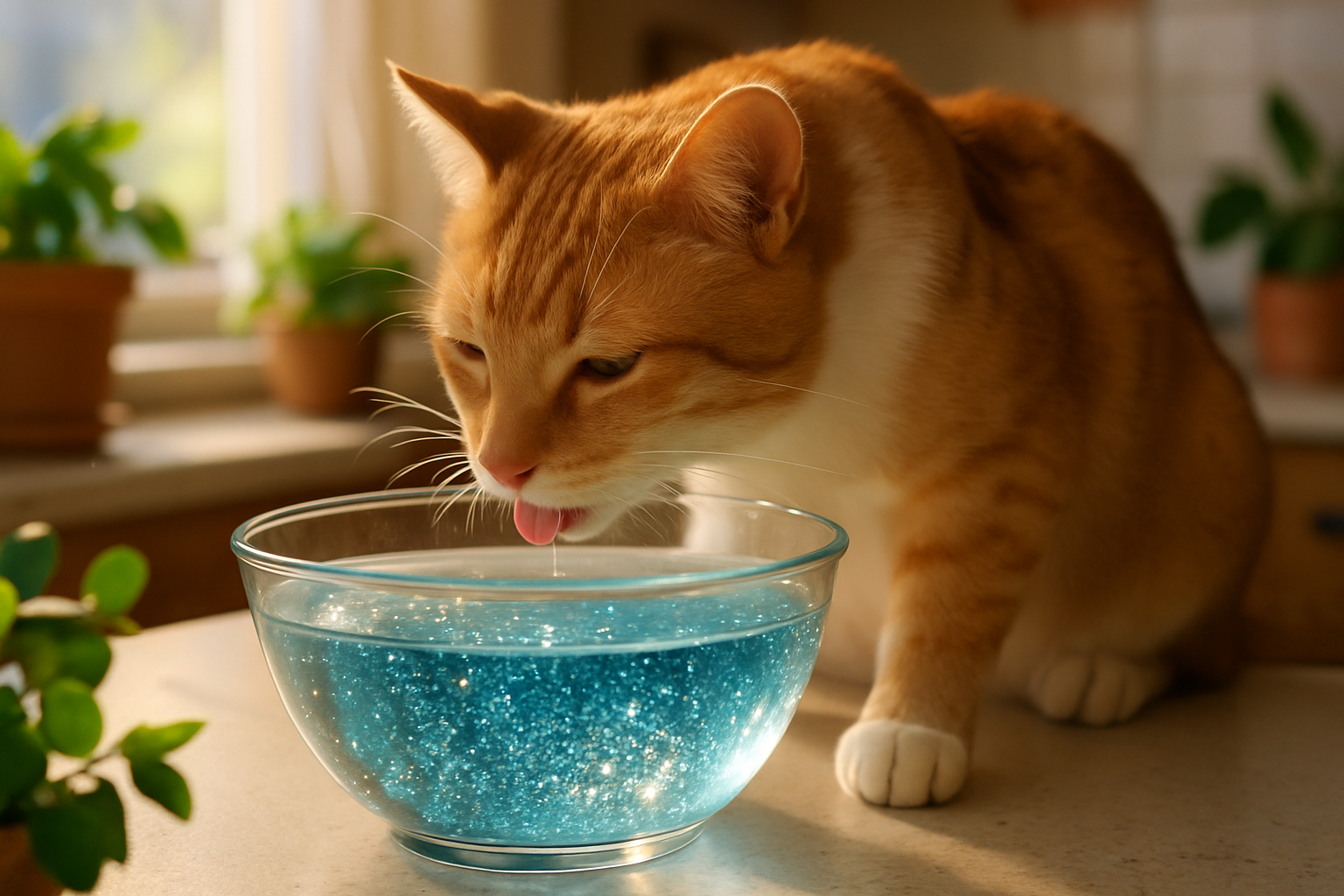Water is a skillfully underrated powerhouse when it comes to your cat’s daily life. You might think it’s just about quenching thirst, but what your feline drinks can seriously shape their health. In recent years, “alkaline cat water” has popped up as a hot topic. Water with elevated pH levels, often touted for human wellness, finds its way into discussions about pet hydration. But the big question is—can cats safely drink alkaline water, or is it a sneaky risk in disguise?
Cats naturally require pure, uncontaminated water, with pH levels ideal for their delicate digestive balance. Yet, alkaline water, with its higher pH, might disturb that balance, especially if your cat drinks it around meals. Experts frequently highlight risks like digestive upset and nutrient absorption troubles, which can lead to more serious health issues long term if ignored.
On the flip side, some owners have observed benefits with carefully limited use of alkaline water, particularly in managing urinary health or joint stiffness. New technologies and products by brands like PetSafe, Brita, and ZeroWater are making filtered, healthier drinking water more accessible for pets, but when alkaline properties come into play, caution is key.
This article dives into the nitty-gritty about drinking fountains like those from Catit, filtration innovations from Pet Water Solutions, and wellness plans incorporating H2O Animal Wellness and Aquapaw. Whether you’re curious about hydration hacks or worried about your cat’s health, we’ll explore why some waters are better left for cats than others.
What Exactly Is Alkaline Water and How Does It Affect Cats’ Health?
If you’ve stumbled upon alkaline water while browsing wellness options, you’ve probably heard buzzwords like “high pH,” “mineral-rich,” and “oxidation-reduction potential,” but what do they really mean for your cat? Alkaline water is water with a pH level above 7, usually in the range of 8 to 9. This means it’s less acidic than regular tap water, which typically rests near 7 or slightly below.
What makes alkaline water distinct are dissolved minerals like calcium, magnesium, potassium, and bicarbonates, which can slightly shift the water’s chemical properties. Notably, the negative oxidation-reduction potential (ORP) of alkaline water means it may act as an antioxidant, scavenging free radicals — a selling point for human health enthusiasts.
But when it comes to cats, things aren’t quite so straightforward. A cat’s stomach naturally maintains a certain acidic environment necessary for breaking down food and killing harmful bacteria. Introducing alkaline water, especially in larger amounts, can neutralize those stomach acids, potentially leading to digestive distress.
Here’s why this matters practically:
- 🐾 Digestive interference: Cats rely on a strongly acidic stomach environment. Too alkaline water may sap this acidity, causing indigestion or nutrient malabsorption.
- 🐾 Urinary health impact: Cats commonly struggle with urinary tract issues. Drinking alkaline water alters urine pH but might not always provide benefits—for some felines, it could increase stone formation risks.
- 🐾 Calcium overload: Alkaline water’s calcium content can be excessive if your cat drinks it routinely, especially dangerous for nursing kittens or older cats prone to hypercalcemia.
While mineral-enhanced water fountains like those from PetSafe or Brita aim to deliver clean, balanced water, alkaline water shifts the pH response, so always check what’s in the bowl. Cats are finicky; they might reject altered water tastes, leading to dehydration risks if alternatives aren’t appealing.
| 🧪 Water Type | 🌡️ Typical pH | 🐱 Effects on Cats | ⚠️ Notes |
|---|---|---|---|
| Tap Water | 6.5 – 7.5 | Generally safe; natural pH ideal for digestion. | May contain minor contaminants; filtered versions preferred. |
| Spring Water | 6.2 – 7.0 | Pure with good taste; supportive of urinary health. | Best if from clean sources, unprocessed. |
| Alkaline Water | 8.0 – 9.0 | May disrupt stomach acidity; risk of digestion issues. | Limited use recommended; avoid around meal times and medicating. |
| Distilled Water | ~7.0 | Sometimes too pure; lacking minerals cats need. | Can lead to mineral deficiencies if sole source. |
How Filtration and Water Solutions Influence Your Cat’s Hydration
In 2025, innovations in pet hydration are booming. Brands like Pet Water Solutions and Aquapaw have introduced pet-friendly water filters, sometimes integrated into drinking fountains, to enhance water purity and appeal.
These devices often:
- 💧 Remove harmful contaminants like chlorine & heavy metals.
- 🛑 Avoid altering pH excessively, maintaining near-neutral levels perfect for cats.
- 🐱 Encourage cats to drink more by offering flowing, fresh water—critical since many cats dislike stagnant water.
For example, PetSafe’s advanced Drinking Fountain models combine filtration media that strongly reduce impurities without raising pH too much, unlike many “alkaline water” systems meant for human use. Their design also reduces odor and keeps water cool, enticing your kitty to hydrate better and stay healthier.
Choosing the right water system means considering:
- 🌿 Water purity: Ensure you’re using filtered water that’s free from pesticides, chlorine, and other chemicals.
- ⚖️ pH balance: Keep water pH within 6.2–7.0 range to complement your cat’s digestive system.
- 🔊 Cat preference: Some cats prefer water from fountains due to aeration and movement, increasing total intake.
Understanding these factors allows you to pick fountains like Catit’s or filtration systems from Brita and ZeroWater that work harmoniously with your feline’s unique physiology without exposing them to risks from alkaline water.
Why Avoiding Alkaline Water Especially After Meals Is Vital for Cats’ Digestive Health
The core caution when it comes to cats and alkaline water lies in what happens post-feeding. Cats produce strong stomach acids designed to dismantle the proteins and fats in their prey or food. This acidic environment is finely tuned to their digestion.
Pouring alkaline water—which neutralizes these acids—right after meals is a recipe for discomfort. It can:
- 🛑 Slow down enzymatic breakdown of food, causing indigestion and sometimes regurgitation.
- 🌡️ Disrupt gut flora balance, resulting in stomach pain and even nausea.
- 🚫 Block absorption of essential nutrients leading to longer-term health problems like vitamin deficiencies.
Veterinarians often note that cats given alkaline water after meals might show signs like lethargy, vomiting, and refusal to eat. Long-term exposure can cause chronic gastrointestinal irritation and contribute to more serious illnesses. This is why many recommend sticking with plain filtered tap or spring water after mealtime.
Here’s a quick checklist for managing your cat’s water intake around meals:
- ⏰ Avoid offering alkaline water within 1-2 hours of feeding.
- 🍽️ Provide fresh, neutral pH water for hydration instead, such as from Brita or ZeroWater filters.
- 💧 Observe your cat for any digestive signs when you change water types.
Getting this routine right is easy with smart hydration products such as Pet Water Solutions’ fountains that deliver consistent pH-balanced water all day long.
Alkaline Water Benefits and Risks for Cats—What the Science Says
Despite concerns, there’s a nuanced conversation about whether alkaline water can offer any health perks for felines. Some studies hint at possible benefits if used carefully and sparingly, while also highlighting dangers if misused.
Potential benefits:
- 🦴 Joint health: Alkaline water’s mineral content, especially calcium, might help maintain cartilage, potentially reducing stiffness in senior cats.
- 💧 Hydration boost: Some cats increase their water intake when they find the taste of mineral-rich alkaline water appealing.
- 🐾 Urinary system assistance: The alkaline pH could help neutralize acidic waste in the bladder, soothing urinary tract discomfort in some cases.
Yet, these perks don’t come without tradeoffs:
- ⚠️ Overwhelming the cat’s delicate pH balance can disrupt whole digestive and metabolic processes.
- 👎 Excess calcium or minerals can elevate risks such as kidney stones or hypercalcemia, especially in vulnerable kittens or nursing cats.
- 😷 Side effects like nausea, vomiting, and muscle tremors have been reported when cats consume too much alkaline water.
| 🧪 Alkaline Water Impact | 👍 Benefits | 👎 Risks |
|---|---|---|
| Joint Care | Possible support via calcium/magnesium minerals. | Too much calcium can cause hypercalciuria and kidney damage. |
| Digestive Health | May temporarily neutralize acid reflux symptoms. | Impaired digestion and nutrient absorption when overused. |
| Urinary Health | May improve hydration and reduce acidity. | Unbalanced urine pH increases risk of stones for some cats. |
Choosing wisely means consulting your veterinarian before introducing alkaline water, especially if your cat has preexisting health conditions or is on medications.
Choosing the Best Water and Hydration Tools for Your Cat’s Long-Term Healthy Pet Lifestyle
Ultimately, providing clean, safe water with the right pH balance is crucial to supporting your cat’s long-term wellbeing. With an array of products aimed at pet hydration on the market, it’s easier than ever to tailor your cat’s water experience.
Here’s how to make confident decisions:
- 🌟 Pick the right filtration system: Tools like Brita and ZeroWater filters remove harmful substances without increasing pH to risky alkaline levels.
- 💧 Invest in a high-quality drinking fountain: Options such as PetSafe, Catit, and Aquapaw fountains encourage hydration with continuous flow and filtered water.
- 🔍 Monitor water pH regularly: Affordable pH test kits can keep you in control of the water quality you offer your cat.
Remember these key points about water for cats:
| 💡 Key Factor | 🔑 Recommendation | 🐱 Benefit for Cats |
|---|---|---|
| pH Level | Maintain 6.2 to 6.4 | Optimizes digestion and reduces urinary complications. |
| Water Source | Filtered tap or clean spring water | Ensures pure, palatable hydration. |
| Hydration Device | Use PetSafe or Catit Drinking Fountains | Encourages regular drinking, preventing dehydration. |
Proper hydration sets the cornerstone for any Healthy Pet plan, and when paired with good nutrition and care, it boosts your cat’s quality of life. Avoid unknown waters with unexplored mineral content or high pH; your feline friend deserves the best.
Frequently Asked Questions About Cats and Alkaline Water
- ❓ Can cats drink alkaline water daily?
It’s best to limit alkaline water to small amounts and avoid giving it around meals or medication times. Daily consumption is usually not recommended without veterinary guidance.
- ❓ What pH level is ideal for cat water?
The ideal pH range for cats is between 6.2 and 6.4, which suits their digestive and urinary tract health well.
- ❓ Is filtered tap water okay for cats?
Yes! Filtered tap water via Brita or ZeroWater systems is safe and often the preferred choice for keeping contaminants out while maintaining good taste and balanced pH.
- ❓ Can alkaline water help with a cat’s kidney disease?
Some vets suggest alkaline water might aid cats with certain kidney issues by neutralizing acid buildup, but this should only be under professional care.
- ❓ Are there any products that offer both filtration and proper pH water?
Definitely! PetSafe and Catit offer combined filtration and fountain solutions that keep water clean and close to ideal pH for felines.

